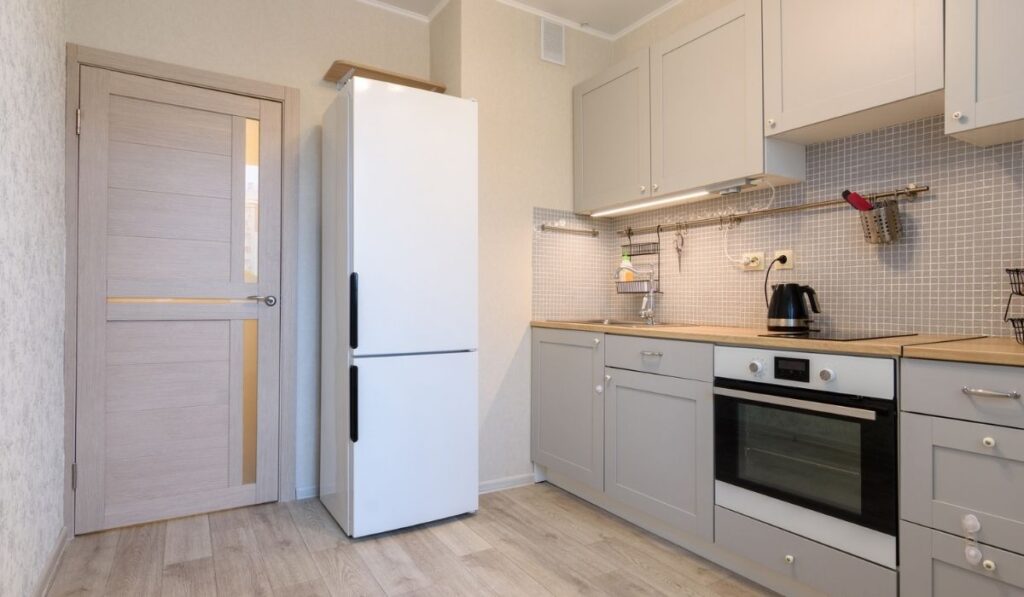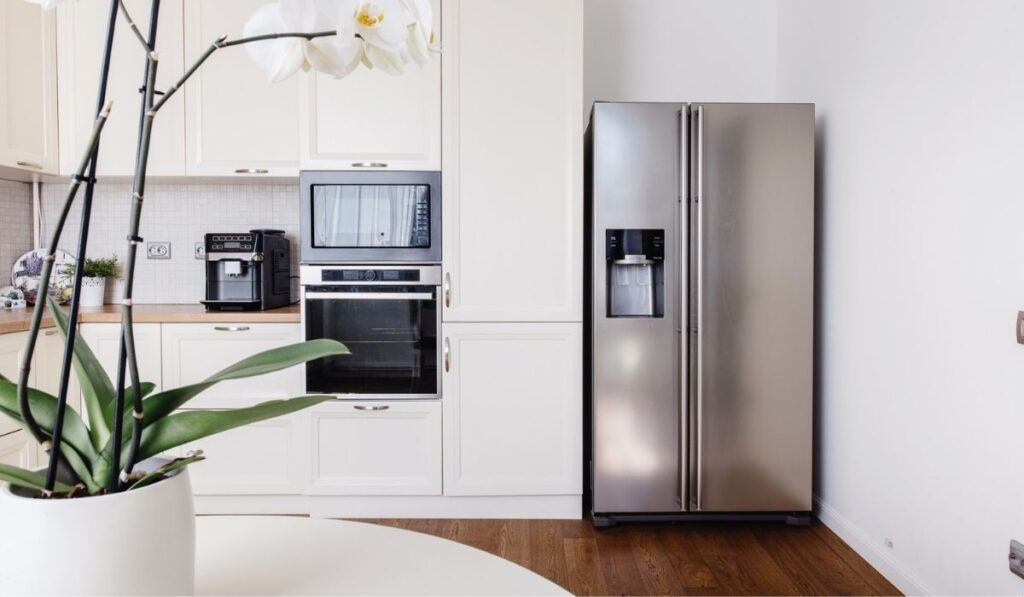Refrigerators are undoubtedly one of the most important appliances in any home and, as such, deserve special care. Usually, they get a prime spot in the kitchen, away from heat, in a safe corner. But what if you want to put your refrigerator on the carpet? Is that a good idea?
Putting your fridge on a carpet should be avoided if possible. The carpet may block airflow and cause overheating. Water leaks and mold could also affect the carpet itself. But if the carpet is a must, your best option is to put a mat or piece of wood under the fridge or elevate it on a stand.
Adequate airflow and balance are essential to keeping your refrigerator running optimally. Fridges can get compromised when placed on soft surfaces like a carpet. And the carpet itself could be damaged by the refrigerator. So, let’s look at the potential risks and some solutions for safely putting your fridge on the carpet.
Can You Put a Refrigerator on a Carpet?

No, it would be best to never put a refrigerator on a carpet. Refrigerators must be placed on a solid base and at least several inches away from the wall on all sides. There are several risks associated with putting a fridge on the carpet, including:
1. Poor Air Circulation
Refrigerators need plenty of ventilation to dissipate heat, and they have condenser vents on the bottom and back to facilitate this. Carpets can block these vents and cause the fridge to overheat, and possibly damage the compressor and other components.
The wear is not limited to the fridge; if the heat becomes too intense, it’ll undoubtedly roast the carpet and may cause a fire.
2. Water Damage
Modern refrigerators have drain pipes, and older versions drip water into a tray at the bottom, but it’s not uncommon to have water leaks in both cases. If your fridge is on the carpet and leaks, the water will soak into the carpet, making it a breeding ground for mold and mildew.
The worse part is that you may not notice the damage until the carpet starts to stink badly.
3. Structural Damage to the Carpet
Fridges are heavy, and when you put them on an already soft surface like a carpet, they leave ugly bald patches in the fibers. This looks terrible and causes permanent damage that’s difficult and expensive to repair.
Compressed carpet can also affect the fridge’s balance, which can strain the door and create problems with water drainage.
Can You Put a Mini Fridge on Carpet?
No, it’s not a good idea to put a mini-fridge on the carpet. Regular or mini-fridges work the same way; both produce heat and need ventilation.
Mini-fridges may have more vents on the bottom because they are smaller and are thus more susceptible to overheating if put on the carpet. So, consider the same placement issues and risks discussed in the previous section.
What if the Carpet Needs to Be There?
Now you know a few good reasons to avoid putting a refrigerator on the carpet, but if you have no other choice, there are a few things you can do to minimize the damage. Let’s review some of the options.
Use Refrigerator Stands
Stands are used to elevate the fridge off the ground; you might have seen one under grandma’s old fridge. These stands or frames allow for better ventilation and prevent heat damage to your carpet.
They come in adjustable sizes, heights, and materials, like wood, plastic, or metal. You can also find them with or without wheels. The only issue is that larger units and double-door refrigerators may not have many stand options.
Place Hard Boards on the Carpet
Any thick, sturdy board like Plywood, MDF, or other dense pressed wood would work as a platform for your fridge. The key is to make sure it’s a solid and non-slippery surface so the fridge won’t sink in or move around. You can also cut and fit a custom size if needed.
Spread Vinyl Sheets
If you’re looking for a temporary fix, vinyl sheets are a great option. Of course, they aren’t as aesthetic as a nice rug, but they work in a pinch. You can find them at any hardware store, and they’re really easy to install. Just make sure you get the kind that is water and heat-resistant.
Use a Durable Mat
Mats are probably the most affordable and aesthetically pleasing options to put under your fridge. They’re cheap, come in all shapes and sizes, are easy to move, and you can always find one to fit your style.
A good mat will protect your carpet from spills and dissipate any heat the fridge gives off. They’re also super easy to clean; vacuum them out or throw them in the wash every once in a while.
But the most important thing is to get a mat that’s suitable for the job. A flimsy mat won’t make much of a difference in this situation.
It would help if you had a durable mat that’s waterproof but also breathable. Something with a thick weave is ideal for minimizing the amount of damage to your carpet. It’s also good to get one with a non-slip backing, so it stays in place. Here we have a few good options for you:
1. Gorilla Grip Durable Natural Rubber Door Mat
This natural rubber doormat is a great option to go under your fridge. It’s only half a centimeter thick, and the patterned surface isn’t as brushy as carpet. It’s also water-resistant to avoid spills from wreaking havoc on your carpet.
Gorilla mats (on Amazon) have so many designs and color options you’re sure to find one that complements your kitchen décor.
2. Mibao Durable Large Outdoor Rug
The Mibao rug (on Amazon) is made to soak up as much water as possible, so any spills will quickly be absorbed. It dries equally fast, so there’s no risk of mold or mildew. Plus, its wick structure traps dirt or dust, so your rug always looks clean. It’s also a premium option with eco-friendly materials.
3. Yimobra Heavy Duty Floor Rug
The Yimobra rug (on Amazon) is made with a combination of polyester fiber top and rubber backing. This makes the rug an easy-to-clean absorbent, while the beveled rubber backing gives an anti-slip grip. Plus, the Yimobra has a stylish thick pattern, dissipates heat quickly, and looks great in any room.
4. REFETONE Super Absorbent Dirt Resistant Rug
This low-profile rug is available in multiple colors and is designed to trap dirt, dust, and moisture. It’s also non-slip, water-resistant, and machine-washable, so it’s easy to keep clean. The REFETONE mat (on Amazon) is a good option if you have kids and pets, as it’s practically impossible to stain.
Whichever option you choose, be sure to think about the size of your refrigerator and the condition of your carpet. With a little bit of preparation, you can keep your fridge from ruining your expensive flooring and keep your kitchen looking great.
How Can You Maintain a Refrigerator on a Carpet?
If you have no choice but to put your refrigerator on the carpet, take a few more precautions to ensure that both your fridge and carpet stay in good condition. Here are a few tips:
- It’s absolutely necessary to put something between the fridge and the carpet. Use any of the options we discussed in the previous section: a piece of plywood, a mat, or just some plastic sheets. Whatever you use to protect the carpet, make sure it’s anti-slip and big enough to cover the entire fridge.
- When you put the refrigerator on the carpet, the side with more weight will sink more, or if any one of its legs is on the ground, the fridge will tilt, which results in an unbalanced unit. This could cause water drainage issues or improper door closure, and it definitely won’t look good. So, be extra careful in leveling your fridge. You can use a spirit level or just eyeball it to make sure it’s as straight as possible.
- Periodically check the refrigerator coils, and clean them if necessary. If they get too dirty, your refrigerator won’t run as efficiently and might even break down. If possible, get a compact refrigerator with coils on the back only.
- Most modern refrigerators now come with proper drainage systems, but if your fridge doesn’t have that, keep a close eye on the drip pan and empty it when necessary. Also, check for any leaks in the pan or around the fridge and repair them to prevent water damage.
- Regular maintenance is key to keeping your refrigerator on the carpet. Make sure you clean the interior and exterior and get professional help whenever you think something might be wrong.
Follow these simple tips, and your fridge should function properly, even on your expensive carpet.
Proper Fridge Installation Tips

Placement makes a big difference when it comes to refrigerators. You have to think about allocating enough space, proper ventilation, and electrical outlet availability even before buying one.
But all the effort will be worth it when you’ve got a well-stocked, functional fridge in your kitchen. Here we have a small guide with a few tips on installing a refrigerator properly.
- The first and most important thing is to measure the available space in your kitchen. Especially if you have alcoves or a built-in area for the fridge, you’ll need to take accurate measurements.
Measure the height, width, and depth of the space, and take an extra measurement from the middle to rule out an odd shape. If you’re going to place the refrigerator in an open space, make sure it’s not too close to the stove, dishwasher, or any other heat-producing appliance. - Once you have the measurements, it’s time to select a fridge. You can go for a bottom-freezer, top-freezer, or side-by-side model. Just remember that refrigerators need ventilation space. So whatever model you choose, make sure there is at least one inch of space on each side and two inches at the top and back.
Also, factor in the opening margin of the door; if your fridge has a water and ice dispenser on the exterior, it will need more space on the hinge side. Only place your order when you’re absolutely sure that the fridge fulfills these criteria. - Once you have the fridge in hand, it’s time to start the installation process. First, prepare the space by removing any old wires, appliances, or cabinets that might be in the way. Next, ensure that all the attachments like water lines, drainage, and power cords are accessible and working. Then place a hardboard or plywood board on the floor to protect it.
- The next step is to place the fridge in its designated spot. It’s always a good idea to get someone’s help because these appliances are quite heavy and delicate. Some refrigerators come with wheels; if you’re lucky to have one of those, wheel it into place.
- Once the fridge is halfway into the desired spot, connect the waterline. Usually, the manufacturer provides clear instructions for doing this, so make sure you follow them closely.
- Next, make sure that the fridge is level. Open and close the door a few times to check. If it’s not level, the door might not close properly, which can then cause issues with the compressor.
- Don’t hurry to plug it in just yet. Leave the fridge unplugged for at least five hours — or more, if you can. This will let the coolant settle after all the movement and prevent any damage to the compressor. When you finally plug it in, run the fridge empty for several hours before putting any food inside.
